This article describes the full load current formula and calculations for the electrical equipment that operates on AC and DC.
What is a Full Load Current?
The full load current of an electrical machine is the maximum current that equipment can safely carry without damage. The conductor of an electrical machine has a specific current carrying capacity according to the machine rating. The excess current above the rated full load current produces additional heat in the electric machine. This additional heat can not be dissipated efficiently because the machine’s cooling system is designed to disparate the heat generated at full load current.
If the current above the full load current(FLC) flows in a winding, the additional heat loss increases in the proportionality of the square of the current. The heat generation in the winding is equal to the product of resistance and square of the current(I2R). The insulation system of the electrical system is most vulnerable to increased heating of the machine. The increased temperature deteriorates the insulation life of the machine.
The insulation life becomes half with every additional increase in temperature by 10 Deg C. The increased temperature of the machine may lead to insulation failure. Therefore, no electrical machine must run above the machine’s full load current(FLC).
Table of contents
Alternating Current AC Loads
The AC loads are of three types.
- Resistive Load – Heater, room heater, and resistive elements
- Inductive Load – Induction furnace, single-phase induction motor, three-phase induction motor
- Capacitive Load – Capacitor banks, open-circuited transmission line
Now, we will discuss the AC DC Full Load Current Formula for three-phase induction motors, single-phase induction motors, heaters, and DC Machines.
Full Load Current Formula for AC and DC
3-phase Induction Motor Full Load Current Formula
The stator of a 3-phase induction motor may have a connection in the star or delta configuration. The input power remains the same irrespective of the type of connection, star, or delta.
Star Connected Motor
Let the phase voltage and current of the motor be Vph & Iph. The phase power(Pp) is the product of current, voltage, and power factor.

Thus, the total power (Pt)of all the three phases will be;

We can calculate the motor’s full load current(FLC) from the above formula.

Measuring the motor’s phase voltage is impossible because the neutral point is formed inside the motor and not brought out of the machine. The relationship between the phase voltage and line voltage(Phase to phase voltage) in star connection is;
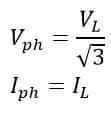
Therefore, the full load current of a star-connected 3-phase induction motor is;

Delta Connected Motor
In a delta-connected stator, the phase voltage equals the line voltage, which is 58 % of the line current.
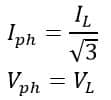
Therefore, the full load current of a delta-connected 3-phase induction motor is;
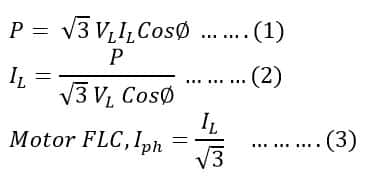
Single-phase Motor
The full load current(FLC) of a single-phase induction motor is;
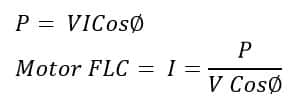
Single-phase Heater
The heater is a resistive type load, and the power factor of the resistive load is unity. The full load current(FLC) of a single-phase heater is;
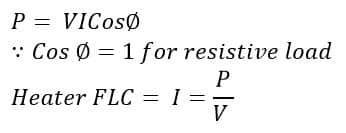
Calculation of Heater FLC by measuring Resistance and Power
- Measure the resistance of the heater by a multimeter. Let it be R.
- Measure the power after connecting the heater to the circuit.
- Calculate the full load current of the heater using the formula given below.
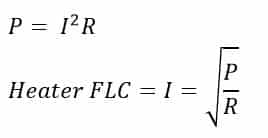
Full Load Current Formula for Three-phase Heater
The full load current of a three-phase heater is;
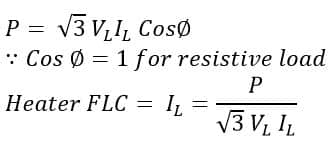
Full Load Current Calculation of DC Machine
In a DC circuit, the power factor does not occur, and the power of the DC machine is simply the product of voltage and current.

The supply voltage(V) of the DC shunt and series machines are given below.
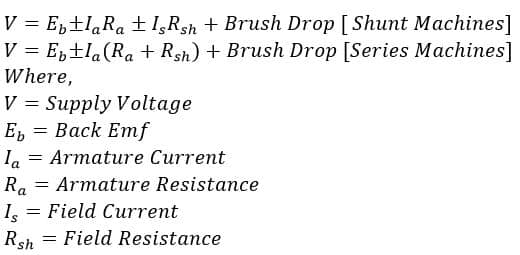
The back EMF of the DC machine is;
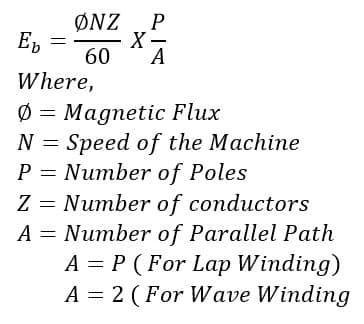
Summary of Full Load Current Formula
| Full load current Calculation | full load current Formula |
| FLC for 3-phase load in kW |  |
| FLC for 3-phase load in kVA |  |
| FLC for 3-phase load in hp |  |
| FLC for 1-phase load in kW |  |
| FLC for 1-phase load in kVA |  |
| FLC for 1-phase load in hp |  |
| FLC for DC load in kW |  |
| FLC for DC load in hp |  |
Solved Problems
Q.1 The 3-phase induction motor’s rated voltage, power, and power factor are 440 Volts, 55 kW, and 0.90, respectively. Calculate its full load current.
Given Data-
PkW= 55 kW
V= 440 V
cosΦ= 0.90
Full load current formula for 3-phase AC

Q.2 A 3-phase heater’s rated voltage and power are 440 Volts and 5kW, respectively. Calculate its full load current.
Given data-
Pkw= 5
V= 440
cosΦ= 1 ( Heater is a resistive load)
Full load current formula for 1-phase AC

Q.3 The voltage and power rating of a 3-phase transformer are 440 volts and 50kVA, respectively. Calculate its full-load current.
Given Data-
SkVA=50
V= 440 Volts

Q. 4 The voltage and power rating of a 1-phase transformer are 220 volts and 5kVA, respectively. Calculate its full-load current.
Given Data-
SkVA=5
VLN= 220 Volts

Q. 5 The voltage, power rating, and power factor of a 1-phase induction motor are 220 volts, 1kW, and 0.88, respectively. Calculate its full-load current.
Given Data-
PkW=1
VLN= 220 Volts
cosΦ= 0.88
Full load current formula for 1-phase AC

Q.6 The 3-phase induction motor’s rated voltage, power, and power factor are 400 Volts, 45 hp, and 0.92, respectively. Calculate its full load current.
Given Data-
Php= 45 kW
V= 400 V
cosΦ= 0.92
